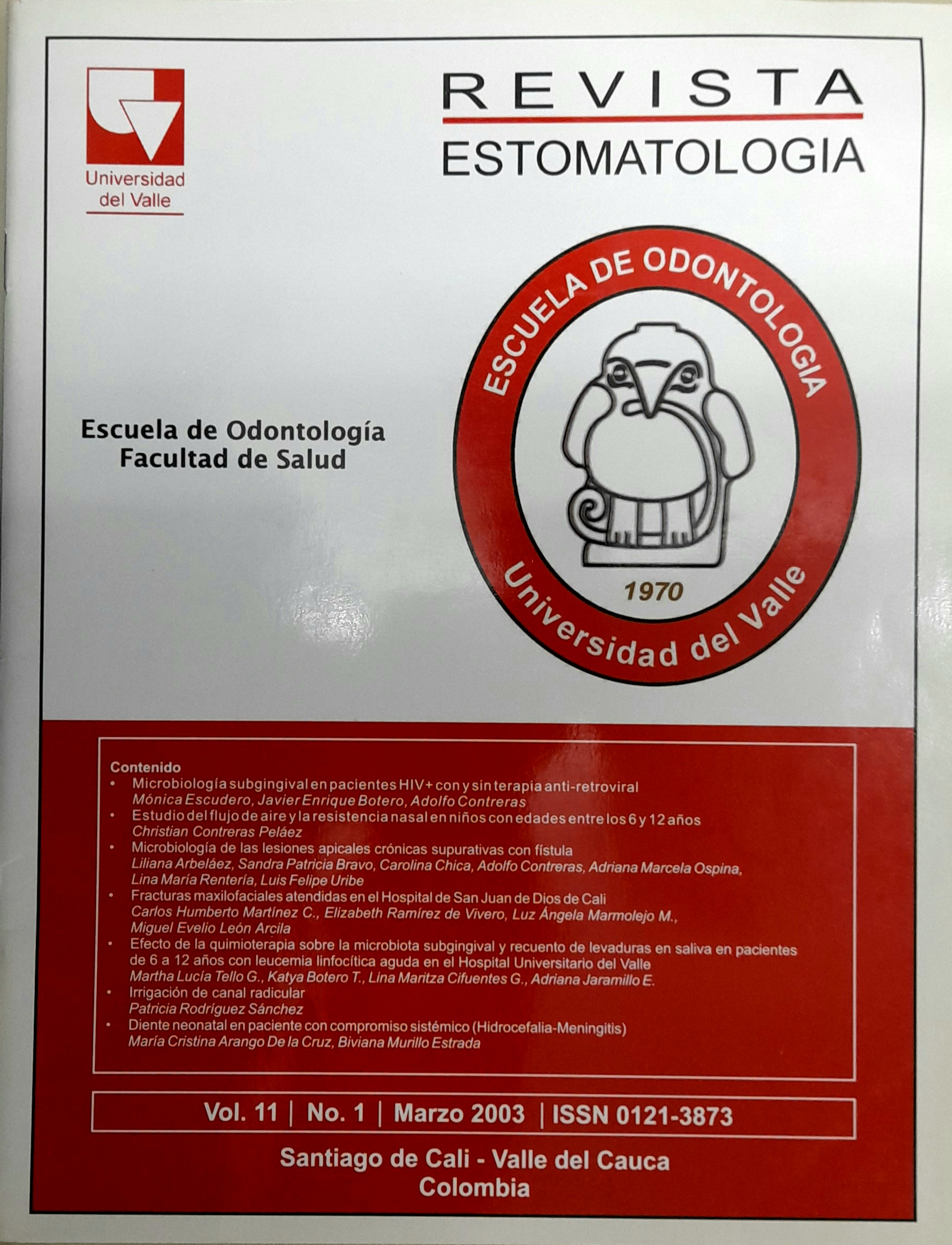Microbiología de las lesiones apicales crónicas supurativas con fístula
Main Article Content
The microbiology of24 teeth with Suppurative Chronic Apical Periodontitis and fistula lesions were identified. F orty eight samples were taken from adult patients that attended to the Dental School atthe Universidad del Valle, Cali-Colombia. Root canal samples were taken after crown drilling and disinfection which inc1uded also the adjacentmucous ofthe fistulous tract. Root canal samples were recovered with a 08 Maillefer ® sterile file overstepping 2mm in the apicallesion. Fistula samples were recovered using # 15 Meta Dental Co ® sterile paper points. Both, fistula and root canal samples were transfered to VMGA III transport media and processed at least 24 hours after sampling. Plating took place at the Oral Microbiology laboratory using selective media such as TSVB and non-selective media such as BBL plates supplemented with 5% sheep bloodlhemin adnmenadione. Anaerobic and facultative culture were incubated for 5 days. Microbiological determination was done using stereostopic microscopy for microbial colony morphology and rapid biochemical test. This study identified eighteen bacteria species. The more frequent species in root canals were: Streptococcus anaerobios and Fusobacterium sp (20.8%) 5 cases, Prevotella intermedia and Peptostreptococcus micros (16. 7%) 4 cases, Eubacterium sp and Gram () enteric rods (12.5%) 3 cases. The more frequent species in the fistula samples were: Porphyromonas gingivalis (33.3%) 8 cases, Streptococcus anaerobios (29.2%) 7 cases, Peptostreptococcus micros (25%) 6 cases. According to this results, the presence of pathogenic bacterias in the periapieallesion and in the fistulous traet may be important beeause the determination of endodontic mierobiolgy would be useful to eomplement the meehanieal therapy with antibiotic treatment.
- Lina María Villegas, Judy Elena Villavicencio, Adolfo Contreras, Dietary intake and early childhood caries , Revista Estomatología: Vol. 26 No. 2 (2018)
- Jorge-Enrique Soto-Franco, Heberth-Fernando Aldana, Juan-Manuel Navia, Melissa Peláez, Jorge Quisoboni, María-Alexandra O'Meara, Adolfo Contreras, High sensitive- C reactive protein, periodontal parameters and periodontal microbiota after scaling-root planning plus Azithromycin as treatment of Chronic Periodontitis: A Randomized Clinical Trial , Revista Estomatología: Vol. 24 No. 2 (2016)
- Adolfo Contreras, Pathogenesis of Periodontal Disease , Revista Estomatología: Vol. 2 No. 2 (1992)
- Marietta Celis, Adolfo Contreras, Carmén Elisa Vallejo, La amalgama dental: el material, interacciones con el ambiente oral y contribución a la carga corporal de mercurio , Revista Estomatología: Vol. 3 No. 1 (1993)
- Sandra Amaya, Maria Fernanda Bolaños, Adriana Jaramillo, Jorge Soto, Adolfo Contreras, Periodontal state and subgingival microbiota in preeclamptic women , Revista Estomatología: Vol. 13 No. 2 (2005)
- Adolfo Contreras R., Myriam Astudillo, Luz Helena Daza, Lina Maria García Z., Paola Andrea Gaviria, Beatriz Parra P., Heidy Liliana Rosales, Adriana Jaramiilo E., Contaminación microbiana de los cepillos dentales en pacientes con enfermedad periodontal , Revista Estomatología: Vol. 10 No. 1 (2002)
- Adolfo Contreras, Jorgen Slots, Antibiotic therapy of Periodontal Diseases: A modern context , Revista Estomatología: Vol. 9 No. 1 (2000)
- Jorge Enrique Soto Franco, Beatriz Parra Patiño, Adolfo Contreras Rengifo, Cultivo y caracterización in vitro de una línea celular de fibroblastos gingivales humanos , Revista Estomatología: Vol. 9 No. 1 (2000)
- Mónica Escudero, Javier Enrique Botero, Adolfo Contreras, Microbiología subgingival en pacientes HIV+ con y sin terapia anti-retroviral , Revista Estomatología: Vol. 11 No. 1 (2003)
- , , Editorial , Revista Estomatología: Vol. 14 No. 2 (2006)

This work is licensed under a Creative Commons Attribution-NonCommercial-NoDerivatives 4.0 International License.
Los autores/as conservan los derechos de autor y ceden a la revista el derecho de la primera publicación, con el trabajo registrado con la licencia de atribución de Creative Commons, que permite a terceros utilizar lo publicado siempre que mencionen la autoría del trabajo y a la primera publicación en esta revista.





